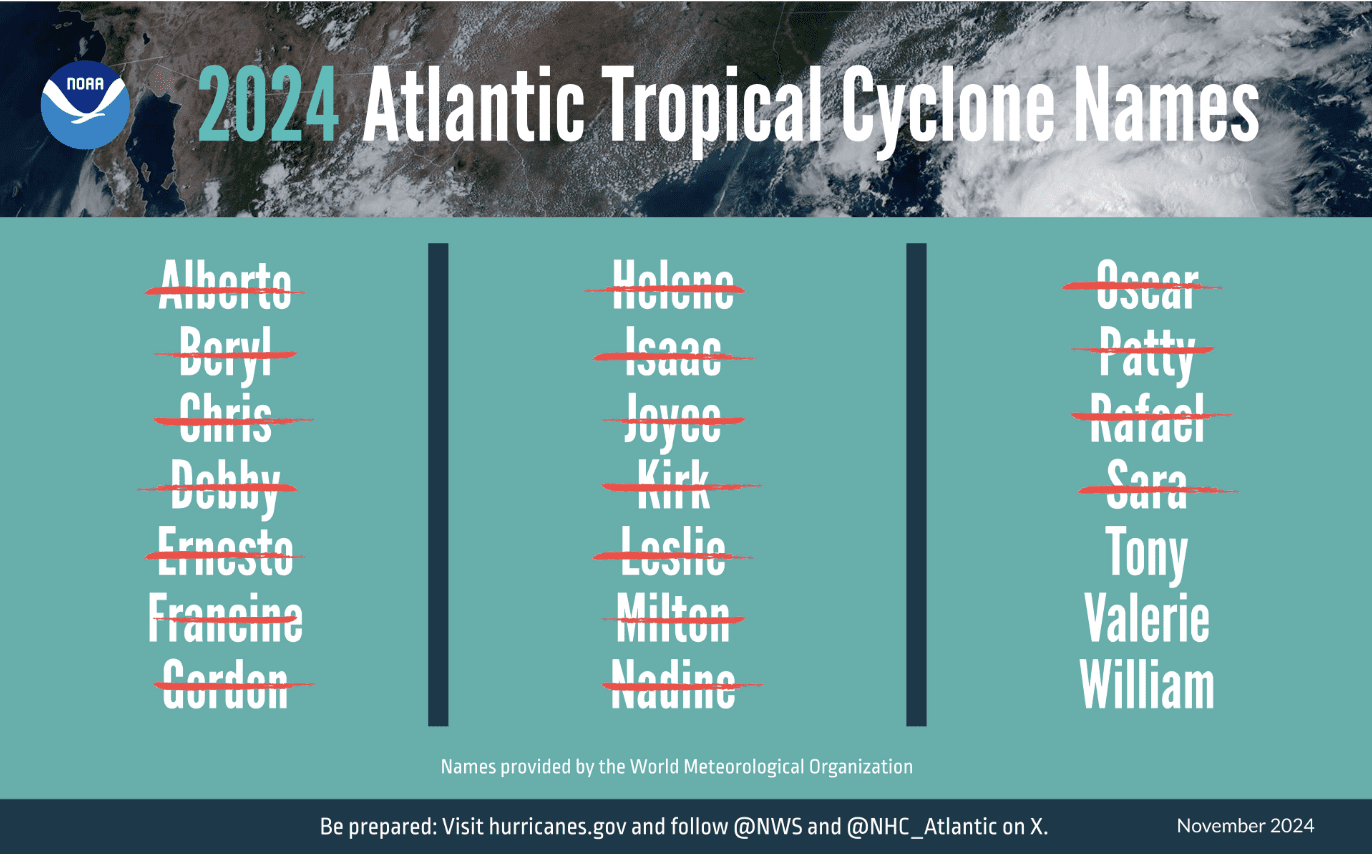Thursday, December 5, 2024, as of 9:00 AM ET
The 2024 Atlantic hurricane season officially ended on November 30, 2024, after a record-breaking year of above-normal activity produced 18 named storms, according to the National Oceanic and Atmospheric Administration (NOAA). Eleven storms became hurricanes, and five intensified into major hurricanes with wind speeds surpassing 111 miles per hour (mph). Of those storms, five made landfall in the continental United States (US).

The 18 Named Storms of 2024: NOAA
This year’s Atlantic seasonal activity fell within the range of NOAA’s initial predictions despite an unprecedented lull in tropical activity leading up to the season’s peak. According to NOAA’s Climate Prediction Center (CPC), several possible factors curbed peak-season development this year, including intense West African winds and rains. However, as consistently high sea surface temperatures ripened conditions for hurricane formation and intensification, activity in the Atlantic quickly ramped up in mid-September, with seven hurricanes forming after September 25 – breaking the record for late-season activity. Additionally, this season surpassed the threshold for “hyperactive” status in terms of accumulated cyclone energy (ACE), which refers to the collective strength and longevity of tropical storms and hurricanes. While an average season produces an ACE value of 122.5 units, this year’s activity generated 161.6 units.
2024 Hurricanes
Overall, three hurricanes defined this season in terms of their impacts and record-breaking formations. Among them is Hurricane Beryl, which rapidly reached peak strength as a Category (Cat) 5 hurricane on July 2 with 165 miles per hour (mph) winds, making history as the earliest Cat 5 hurricane ever recorded in the Atlantic basin. The system also set records with its rapid intensification, strengthening from a tropical depression to a major hurricane in merely 42 hours. According to meteorologists, no other system on record has generated this level of intensification prior to the season’s peak in September. While Beryl weakened to Cat 1 strength before making landfall near Matagorda, Texas, on July 8, the system caused widespread power outages and numerous fatalities in the Houston area.
Then, on September 26, Hurricane Helene made its historic landfall along Florida’s Gulf Coast as a Cat 4 hurricane and the strongest system on record to directly impact the state’s Big Bend region. Helene brought catastrophic storm surge to Florida’s coastal regions and delivered destructive winds and torrential rains to regions as far as southeast Georgia and western North Carolina as it tracked inland. Ultimately, Helene produced 42 trillion gallons of rain across the Southeast, prompting an unprecedented flooding event that devastated southern Appalachian communities. As the mountains funneled fast-moving floodwaters into low-lying areas, entire towns, roads, and structures were washed away. The storm and its remnants caused 1,400 landslides that damaged at least 6,000 miles of roads, over 1,000 bridges and culverts, and roughly 126,000 homes. Helene’s high winds and flooding also resulted in more than 241 confirmed fatalities across six states.
Less than two weeks later, Hurricane Milton made landfall near Siesta Key, Florida, as a Cat 3 hurricane on October 9, generating torrential rainfall, localized flooding, and a tornado outbreak that spawned 46 confirmed tornadoes – setting the record for most tornadoes of any modern-era outbreak. Additionally, Milton’s rapid intensification was among the highest ever observed, generating a 90 mph increase in wind speed in less than a day.
Lessons Learned
The 2024 hurricane season has caused an estimated $500 billion in damages, making it one of the most destructive hurricane seasons in US history. Additionally, the impacts and number of fatalities this year were the greatest seen in nearly two decades, with many of those affected remarkably residing far from where these storms made landfall. According to Hagerty’s Director of Response, Lee Mayfield, the hurricane activity observed this year reinforces a message that emergency managers continuously amplify, which is the importance of preparing for a hurricane, even when you reside outside of the storm’s projected path and “cone of uncertainty.” While reflecting on this year’s storms, Lee states, “You could easily make the case that the most significant impacts were hundreds of miles away from each major storm’s center or landfall point.” Ultimately, emergency managers and local leaders should continue to work together to promote an expansive culture of preparedness, fostering community resilience and, in doing so, saving lives.
Additionally, this season was marked by back-to-back storms with landfalls in close geographic proximity, creating compounding challenges for affected communities. In 2024, Florida was directly impacted by three hurricanes along its Gulf Coast: Hurricane Debby on August 5, Hurricane Helene on September 26, and Hurricane Milton on October 9. According to Lee, “These landfalls in rapid succession wear on both the public and responders, stressing resources and complicating response and recovery efforts.” These circumstances often leave communities in heightened states of vulnerability, making it more difficult for those working to provide comprehensive and timely aid.
Despite these challenges, Lee notes that emergency managers and responders continue their tireless efforts in a “collective mission to save lives and lessen the impacts from these events.” In preparation for and response to the historic devastation from Hurricanes Helene and Milton, many teams deployed to heavily hit areas have worked around the clock over the past three months to ensure ongoing response and recovery efforts. As all those involved continue down a long road to recovery, we commend their remarkable commitment to making a difference and serving those impacted by storms this hurricane season.
To learn more about the unique preparedness, response, and recovery solutions Hagerty offers disaster-impacted communities, visit our Services page.
Stay Updated and Learn More:
- Remember, Ready.gov provides information on how to prepare for a storm and how to keep you and your family safe.
- Understanding the meaning of hurricane maps – a NY Times Opinion Piece: Those Hurricane Maps Don’t Mean What You Think They Mean